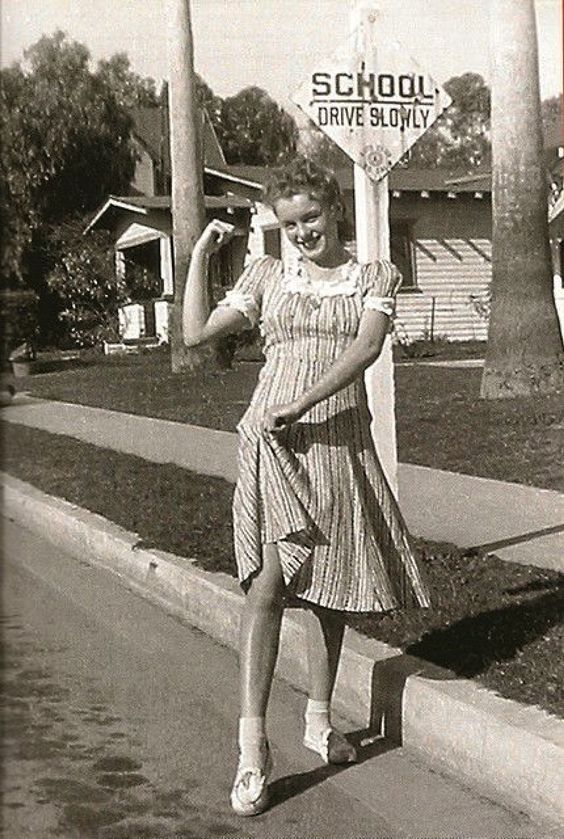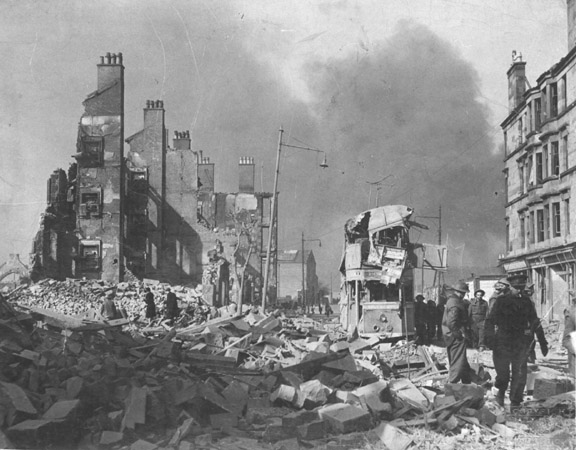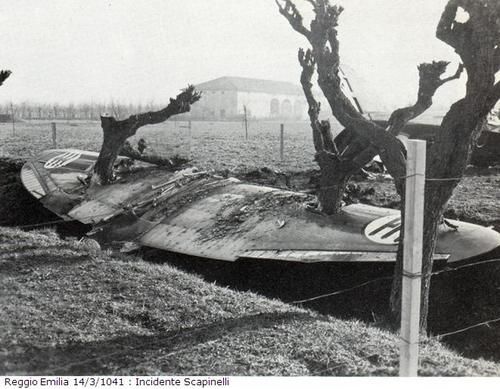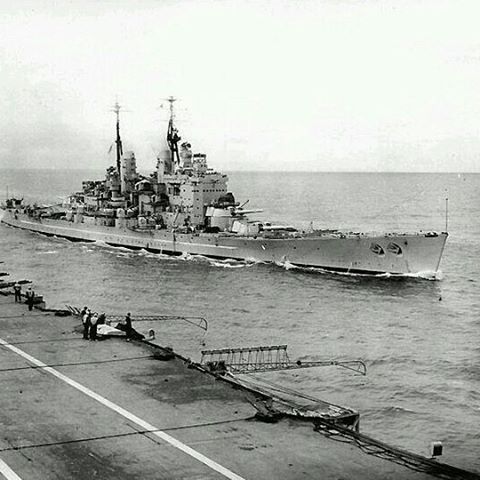Italian/Greek Campaign: The Italian Primavera Offensive has been a giant dud as of 23 March 1941. It has accomplished only local gains at the expense of massive casualties. However, the silver lining for the Italians is that at least they have stopped the Greek progress toward the key port of Valona. Given that the Germans are preparing to invade Greece within the next few weeks, that is sufficient to preserve an Italian presence in the country.
The Italians, despite their failures, continue to believe they can make progress. After dark, the Italians attack around Bubesi in the north and have some success. In fact, they manage to break into the Greek lines. However, the Greeks quickly counterattack and restore their front. It is just another continuation of the long-standing pattern, with a lot of Italian soldiers dead and nothing to show for it.
The RAF raids Berat in south-central Albania.
The Italians continue to reinforce their army in Albania. Four Italian transports/freighters depart from Bari bound for Durazzo in Albania. Greek submarine Triton (Lt.Cdr. D. Zepos, HN) is lying in wait. It torpedoes and damages 5154-ton Italian transport Carnia about 30 nautical miles east of Cape Galo, Brindisi. The Carnia is towed to Brindisi, but ultimately the ship is written off and scrapped. The Triton also attacks 1216-ton freighter Anna Capano but misses.
East African Campaign: Major-General Lewis Heath, in command of 5th Indian Infantry Division, prepares his troops for the next British attack on Keren. Specifically, Dongolaas Gorge is the keyhole that must be entered in order to take the strategic city, but it is heavily defended by Italian troops placed behind the entrance. While the British have made some progress on the flanks, most importantly taking Fort Dologorodoc to the right of the gorge, the gorge itself is as well-defended as ever. After dark, Heath sends reconnaissance patrols to the areas of East Gate Spur and Hillocks "A" and "B," which are major objectives of the coming attack.
The Italians have blocked the gorge itself with boulders and other debris which the British must clear simply to enter it. Given this situation, Heath has decided to attack the Italian defenders of the gorge with a flank attack, which he hopes will give the sappers time to clear the boulders blocking the gorge. This will enable a thrust "up the gut" of the gorge which the Italians cannot stop. The attack is planned for the 24th.
The South African 2nd Division arrives by ship at Berbera, British Somaliland.
The Luftwaffe apparently takes a rest after their major raids on London, Plymouth, and other cities recently. It launches only scattered lone-raider attacks both during the day and after dark.
Visiting Australian Prime Minister Robert Menzies visits recently bombed Plymouth, which he was barred from re-entering on the 22nd due to the catastrophic night attacks. He tours Admiral Nelson's flagship HMS Victory, which Menzies notes has been hit by a bomb. He also witnesses a delayed-fuse bomb being dug up "and try to look as if I feel safe." He then travels to Winston Churchill's estate at Chequers for dinner.
Battle of the Atlantic: U-110 (Kptlt. Fritz-Julius Lemp), on its first patrol out of Kiel, has a very bad day. It attacks 2468-ton Norwegian freighter Siremalm with three torpedoes - a lot for a relatively small ship. Two of the torpedoes miss, and the third hits but proves to be a dud (a common occurrence in northern waters at this stage of the war). Frustrated and unwilling to use any more torpedoes, Captain Lemp surfaces and has his men use the 105 mm deck gun. However, the crew is green, and this is their first time using the gun in action. They forget to remove the gun's tampion (plug) from the barrel, which causes it to explode with the first round. Three men are wounded. Lemp then has his crew use the 37 and 20 mm antiaircraft guns against the ship, but these are like flea bites on an elephant. The Siremalm escapes and U-110 has to head to its new port of Lorient due to the gun incident.
U-551 (Kptlt. Karl Schrott), on its first patrol, is attacked by anti-submarine warfare trawler HMT Visenda about 93 miles south of Iceland. The depth charge attack succeeds, sinking the U-boat, and all 45 men on board perish.
U-97 (Kptlt. Udo Heilmann), on its second patrol operating out of Lorient, is between Cape Farewell, Greenland and southern Ireland (600 miles west of Land's End) when it spots 8077-ton British tanker Chama. Some accounts place this incident on the 24th because it happens right around midnight, and technically the ship may sink on the 24th - but the attack is launched at 23:26 on the 23rd. This is one of those grey areas where different dates are equally valid. All 59 men on board perish.
Royal Navy destroyer HMS Richmond runs aground off Benbane Head at Holyhead, Ireland. After it refloats, it requires repairs at Holyhead and then Southampton that last until 28 May.
The Luftwaffe bombs and sinks 197-ton British trawler Elmira between the Scottish mainland and the Faroe Islands. There are ten deaths and one survivor. To the southwest, the Luftwaffe also damages 221-ton British trawler Samurai.
The Royal Navy scuttles 2624-ton British freighter Tabarka (requisitioned French ship Pollux) in Kirk Sound, Scapa Flow. It later will be temporarily refloated and moved elsewhere.
Minelayer HMS Teviotbank lays minefield BS 52 off the English east coast.
Convoy OB 301 departs from Liverpool, Convoy SL 69 departs from Freetown.
Battle of the Mediterranean: Four freighters of Convoy MW 6 arrive at Malta's Grand Harbour as part of Royal Navy Operation MC-9. They make port in the mid-morning and quickly unload.
The Germans notice the convoy's arrival (apparently) and within an hour the Luftwaffe arrives overhead with another major raid. A large formation of 15 Junkers Ju 88 Stukas attacks, prompting a large RAF response. As usual in these attacks, the Luftwaffe suffers heavily - the RAF and antiaircraft crews claim 13 planes - but the defensive forces on Malta are slight. The British observe that the Luftwaffe Stuka pilots do not attack as aggressively as they have in the past, releasing their bombs before completing a standard dive. There is another raid in the afternoon around 16:00 which damages freighters City of Lincoln and Perthshire, which is set on fire. There apparently is only one death, a sergeant manning an antiaircraft Bofors gun.
After losing 5 planes on the 22nd, the RAF loses another two today. It is becoming clear that the Germans can eliminate the British air defense if they are willing to continue sustaining such large losses. Based on today's raid and the preceding ones, along with invasion fears, the British reach a decision to withdraw all bombers and flying boats from the island. This will vastly reduce reconnaissance capabilities and the ability to bomb Naples and other Italian targets, but the large planes are proving extremely vulnerable to the Luftwaffe attacks, with several recently destroyed and damaged.
The British now are moving troops to Gozo - the island northwest of the main Malta island - due to invasion fears. This is Operation Picnic, and it is disguised from the Italian spies on the island as simply normal troop exercises.
Lieutenant General Erwin Rommel, having received the Oak Leaves to the Knight's Cross at the hand of Adolf Hitler, returns to North Africa. While under orders not to do anything major until he receives his full complement of troops, Rommel orders a small attack on the most advanced British positions west of El Agheila. His Afrika Korps troops in the vicinity of Marada run into British artillery, so they call in the Luftwaffe. Three Bf 110s (known as a Kette) shoot up an English armored car patrol, without much effect, while others attack Solluch.
The recently arrived Brescia Division takes up defensive positions west of El Agheila. Rommel's convoys have been getting through, and the Afrika Corps is stocked with fuel and ready to rumble. The British, meanwhile, have been replacing experienced troops with well-armed but green troops which can charitably be described as garrison units. For instance, the battle-tested 4th Armoured Division has been pulled from the front and sent to Greece. In its place is the 2nd Armoured Division, which is new to the front line and manning a key stretch of the line near El Agheila.
German 8516-ton freighter Oder and Italian 6366-ton freighter India make a run for it from Massawa, Eritrea. The British are patrolling the seas nearby, and escaping will not be easy.
US/Australian Relations: Rear Admiral Newton takes his cruiser squadron (USS Chicago and Portland, along with five destroyers) out of Sydney Harbour after a highly successful visit. He heads to Brisbane for another three-day visit. There have been astonishing street demonstrations in Sydney, with residents acting as if the American ships are their own ships returning from some great, winning battle. Acting Prime Minister Arthur Fadden cables President Roosevelt:
German/Hungarian Relations: Hitler meets with Hungarian Minister of Foreign Affairs László Bárdossy de Bárdos. Bardossy believes that Germany will win the war and works well with Hitler. In general, within the Hungarian government, there is less a sense of kinship with the Germans and more a sense of fatalism that there is no sustainable path other than falling into the German orbit. However, Bardossy is viewed within the Hungarian government as more in line with Hitler than most others and a true fascist.
Yugoslavia: News of regent Prince Paul's decision to sign the Tripartite Pact has seeped out to the population, and demonstrations erupt. Hitler, meanwhile, has imposed a deadline on Yugoslavia to sign the pact on the agreed terms, which include no demands placed upon the Yugoslavian Army to assist the Wehrmacht. If the Yugoslavs do not sign the Pact by the deadline, then these special dispensations (similar to those granted to Bulgaria) will be withdrawn. In essence, Hitler simply wants the Yugoslavian government to permit the right of transit of the Wehrmacht to attack Greece. Of course, once Greece is subdued, Yugoslavia will be surrounded by German-occupied countries so any hope of retaining an independent foreign policy after that would be forlorn.
Brazil: Brazil has large coffee surpluses as a result of the closing of the European markets to imports. Typically, Europe purchases 805 million pounds per year, but due to the war, it is purchasing essentially nothing. The US is the only remaining large customer. The problem is exacerbated by the fact that the 1941 coffee crop is predicted to be the best in years. Coffee prices have collapsed.
Today, the government announces that new uses have been found for the 198,000,000-pound coffee bean surplus remaining from 1940 and an additional 1,436,160,000 pounds purchased by the government. Specifically, it states that plastics created by US scientist Herbert Spencer Polin on the 71st floor of the Chrysler Building called "cafelite" can be created from coffee beans. It is heat-resistant and noise-proof, has good insulating properties, and also is resistant to termites and other pests. The discovery gives hope to Brazilians that the warehouses full of aging coffee beans will prove useful and profitable.
Holocaust: Reichsfuhrer-SS Heinrich Himmler sends a memorandum to Adolf Hitler entitled, "Some thoughts about the treatment of foreign peoples in the Eastern Territories." This topic has been under study by the German government recently as the plans for Operation Barbarossa are finalized. The memo states:
Polish automobile designer Tadeusz Tański, who among other things designed the first Polish armored car and the first Polish serially-built car, perishes in the Auschwitz concentration camp.
China: The Battle of Shanggao continues, with both sides regrouping after the latest Japanese attack. The Japanese are preparing for another surge to begin on the 24th, and today put in minor attacks around Shangkao.
British Homefront: Britain holds a National Day of Prayer at the request of the King.
March 1941
March 1, 1941: Rettungsboje
March 2, 1941: Oath of Kufra
March 3, 1941: Germans in Bulgaria
March 4, 1941: Lofoten Islands Raid
March 5, 1941: Cooperation With Japan
March 6, 1941: Battle of Atlantic
March 7, 1941: Prien Goes Under
March 8, 1941: Cafe de Paris
March 9, 1941: Italian Spring Offensive
March 10, 1941: Humanitarian Aid
March 11, 1941: Lend Lease Becomes Law
March 12, 1941: A New Magna Carta
March 13, 1941: Clydeside Wrecked
March 14, 1941: Leeds Blitz
March 15, 1941: Cruisers Strike!
March 16, 1941: Kretschmer Attacks
March 17, 1941: Happy Time Ends
March 18, 1941: Woolton Pie
March 19, 1941: London Hit Hard
March 20, 1941: Romeo and Juliet
March 21, 1941: Plymouth Blitz
March 22, 1941: Grand Coulee Dam
March 23, 1941: Malta Under Siege
March 24, 1941: Afrika Korps Strikes!
March 25, 1941: Yugoslavia Joins The Party
March 26, 1941: Barchini Esplosivi
March 27, 1941: Belgrade Coup
March 28, 1941: Cape Matapan Battle
March 29, 1941: Lindbergh Rants
March 30, 1941: Commissar Order
March 31, 1941: Cookie Bombs
2020
The Italians, despite their failures, continue to believe they can make progress. After dark, the Italians attack around Bubesi in the north and have some success. In fact, they manage to break into the Greek lines. However, the Greeks quickly counterattack and restore their front. It is just another continuation of the long-standing pattern, with a lot of Italian soldiers dead and nothing to show for it.
The RAF raids Berat in south-central Albania.
The Italians continue to reinforce their army in Albania. Four Italian transports/freighters depart from Bari bound for Durazzo in Albania. Greek submarine Triton (Lt.Cdr. D. Zepos, HN) is lying in wait. It torpedoes and damages 5154-ton Italian transport Carnia about 30 nautical miles east of Cape Galo, Brindisi. The Carnia is towed to Brindisi, but ultimately the ship is written off and scrapped. The Triton also attacks 1216-ton freighter Anna Capano but misses.
East African Campaign: Major-General Lewis Heath, in command of 5th Indian Infantry Division, prepares his troops for the next British attack on Keren. Specifically, Dongolaas Gorge is the keyhole that must be entered in order to take the strategic city, but it is heavily defended by Italian troops placed behind the entrance. While the British have made some progress on the flanks, most importantly taking Fort Dologorodoc to the right of the gorge, the gorge itself is as well-defended as ever. After dark, Heath sends reconnaissance patrols to the areas of East Gate Spur and Hillocks "A" and "B," which are major objectives of the coming attack.
The Italians have blocked the gorge itself with boulders and other debris which the British must clear simply to enter it. Given this situation, Heath has decided to attack the Italian defenders of the gorge with a flank attack, which he hopes will give the sappers time to clear the boulders blocking the gorge. This will enable a thrust "up the gut" of the gorge which the Italians cannot stop. The attack is planned for the 24th.
The South African 2nd Division arrives by ship at Berbera, British Somaliland.
The Luftwaffe apparently takes a rest after their major raids on London, Plymouth, and other cities recently. It launches only scattered lone-raider attacks both during the day and after dark.
Visiting Australian Prime Minister Robert Menzies visits recently bombed Plymouth, which he was barred from re-entering on the 22nd due to the catastrophic night attacks. He tours Admiral Nelson's flagship HMS Victory, which Menzies notes has been hit by a bomb. He also witnesses a delayed-fuse bomb being dug up "and try to look as if I feel safe." He then travels to Winston Churchill's estate at Chequers for dinner.
 |
| British freighter Tabarka, sunk on 23 March 1941 as a blockship at Scapa Flow. |
U-551 (Kptlt. Karl Schrott), on its first patrol, is attacked by anti-submarine warfare trawler HMT Visenda about 93 miles south of Iceland. The depth charge attack succeeds, sinking the U-boat, and all 45 men on board perish.
U-97 (Kptlt. Udo Heilmann), on its second patrol operating out of Lorient, is between Cape Farewell, Greenland and southern Ireland (600 miles west of Land's End) when it spots 8077-ton British tanker Chama. Some accounts place this incident on the 24th because it happens right around midnight, and technically the ship may sink on the 24th - but the attack is launched at 23:26 on the 23rd. This is one of those grey areas where different dates are equally valid. All 59 men on board perish.
Royal Navy destroyer HMS Richmond runs aground off Benbane Head at Holyhead, Ireland. After it refloats, it requires repairs at Holyhead and then Southampton that last until 28 May.
The Luftwaffe bombs and sinks 197-ton British trawler Elmira between the Scottish mainland and the Faroe Islands. There are ten deaths and one survivor. To the southwest, the Luftwaffe also damages 221-ton British trawler Samurai.
The Royal Navy scuttles 2624-ton British freighter Tabarka (requisitioned French ship Pollux) in Kirk Sound, Scapa Flow. It later will be temporarily refloated and moved elsewhere.
Minelayer HMS Teviotbank lays minefield BS 52 off the English east coast.
Convoy OB 301 departs from Liverpool, Convoy SL 69 departs from Freetown.
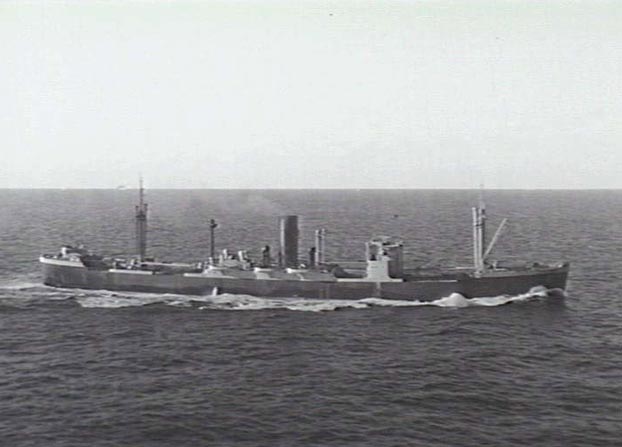 |
| SS Perthshire, set on fire at Malta today immediately after arriving with Convoy MW 6. |
The Germans notice the convoy's arrival (apparently) and within an hour the Luftwaffe arrives overhead with another major raid. A large formation of 15 Junkers Ju 88 Stukas attacks, prompting a large RAF response. As usual in these attacks, the Luftwaffe suffers heavily - the RAF and antiaircraft crews claim 13 planes - but the defensive forces on Malta are slight. The British observe that the Luftwaffe Stuka pilots do not attack as aggressively as they have in the past, releasing their bombs before completing a standard dive. There is another raid in the afternoon around 16:00 which damages freighters City of Lincoln and Perthshire, which is set on fire. There apparently is only one death, a sergeant manning an antiaircraft Bofors gun.
After losing 5 planes on the 22nd, the RAF loses another two today. It is becoming clear that the Germans can eliminate the British air defense if they are willing to continue sustaining such large losses. Based on today's raid and the preceding ones, along with invasion fears, the British reach a decision to withdraw all bombers and flying boats from the island. This will vastly reduce reconnaissance capabilities and the ability to bomb Naples and other Italian targets, but the large planes are proving extremely vulnerable to the Luftwaffe attacks, with several recently destroyed and damaged.
The British now are moving troops to Gozo - the island northwest of the main Malta island - due to invasion fears. This is Operation Picnic, and it is disguised from the Italian spies on the island as simply normal troop exercises.
Lieutenant General Erwin Rommel, having received the Oak Leaves to the Knight's Cross at the hand of Adolf Hitler, returns to North Africa. While under orders not to do anything major until he receives his full complement of troops, Rommel orders a small attack on the most advanced British positions west of El Agheila. His Afrika Korps troops in the vicinity of Marada run into British artillery, so they call in the Luftwaffe. Three Bf 110s (known as a Kette) shoot up an English armored car patrol, without much effect, while others attack Solluch.
The recently arrived Brescia Division takes up defensive positions west of El Agheila. Rommel's convoys have been getting through, and the Afrika Corps is stocked with fuel and ready to rumble. The British, meanwhile, have been replacing experienced troops with well-armed but green troops which can charitably be described as garrison units. For instance, the battle-tested 4th Armoured Division has been pulled from the front and sent to Greece. In its place is the 2nd Armoured Division, which is new to the front line and manning a key stretch of the line near El Agheila.
German 8516-ton freighter Oder and Italian 6366-ton freighter India make a run for it from Massawa, Eritrea. The British are patrolling the seas nearby, and escaping will not be easy.
US/Australian Relations: Rear Admiral Newton takes his cruiser squadron (USS Chicago and Portland, along with five destroyers) out of Sydney Harbour after a highly successful visit. He heads to Brisbane for another three-day visit. There have been astonishing street demonstrations in Sydney, with residents acting as if the American ships are their own ships returning from some great, winning battle. Acting Prime Minister Arthur Fadden cables President Roosevelt:
It is my privilege and pleasure to inform you personally that the visit of the squadron has been in every way an outstanding success and has, I am sure, done even more than we here had hoped to strengthen ties of friendship between australia and the United States of America.The government and population remain highly apprehensive about Japanese aggression to the south, which no doubt contributes to all the warm feelings.
German/Hungarian Relations: Hitler meets with Hungarian Minister of Foreign Affairs László Bárdossy de Bárdos. Bardossy believes that Germany will win the war and works well with Hitler. In general, within the Hungarian government, there is less a sense of kinship with the Germans and more a sense of fatalism that there is no sustainable path other than falling into the German orbit. However, Bardossy is viewed within the Hungarian government as more in line with Hitler than most others and a true fascist.
Yugoslavia: News of regent Prince Paul's decision to sign the Tripartite Pact has seeped out to the population, and demonstrations erupt. Hitler, meanwhile, has imposed a deadline on Yugoslavia to sign the pact on the agreed terms, which include no demands placed upon the Yugoslavian Army to assist the Wehrmacht. If the Yugoslavs do not sign the Pact by the deadline, then these special dispensations (similar to those granted to Bulgaria) will be withdrawn. In essence, Hitler simply wants the Yugoslavian government to permit the right of transit of the Wehrmacht to attack Greece. Of course, once Greece is subdued, Yugoslavia will be surrounded by German-occupied countries so any hope of retaining an independent foreign policy after that would be forlorn.
 |
| The Band of the 15th (Vancouver) Coast Brigade marches down Georgia Street past the Vancouver Hotel. 23 March 1941 (Vancouver Gunners). |
Today, the government announces that new uses have been found for the 198,000,000-pound coffee bean surplus remaining from 1940 and an additional 1,436,160,000 pounds purchased by the government. Specifically, it states that plastics created by US scientist Herbert Spencer Polin on the 71st floor of the Chrysler Building called "cafelite" can be created from coffee beans. It is heat-resistant and noise-proof, has good insulating properties, and also is resistant to termites and other pests. The discovery gives hope to Brazilians that the warehouses full of aging coffee beans will prove useful and profitable.
Holocaust: Reichsfuhrer-SS Heinrich Himmler sends a memorandum to Adolf Hitler entitled, "Some thoughts about the treatment of foreign peoples in the Eastern Territories." This topic has been under study by the German government recently as the plans for Operation Barbarossa are finalized. The memo states:
I hope to see the very concept of Jewry completely obliterated.Hitler tells Himmler to keep this top secret.
Polish automobile designer Tadeusz Tański, who among other things designed the first Polish armored car and the first Polish serially-built car, perishes in the Auschwitz concentration camp.
China: The Battle of Shanggao continues, with both sides regrouping after the latest Japanese attack. The Japanese are preparing for another surge to begin on the 24th, and today put in minor attacks around Shangkao.
British Homefront: Britain holds a National Day of Prayer at the request of the King.
 |
| The New Yorker - 23 March 1946 - Issue # 1101 - Vol. 22 - N° 6 - Cover by Helen E. Hokinson. |
March 1941
March 1, 1941: Rettungsboje
March 2, 1941: Oath of Kufra
March 3, 1941: Germans in Bulgaria
March 4, 1941: Lofoten Islands Raid
March 5, 1941: Cooperation With Japan
March 6, 1941: Battle of Atlantic
March 7, 1941: Prien Goes Under
March 8, 1941: Cafe de Paris
March 9, 1941: Italian Spring Offensive
March 10, 1941: Humanitarian Aid
March 11, 1941: Lend Lease Becomes Law
March 12, 1941: A New Magna Carta
March 13, 1941: Clydeside Wrecked
March 14, 1941: Leeds Blitz
March 15, 1941: Cruisers Strike!
March 16, 1941: Kretschmer Attacks
March 17, 1941: Happy Time Ends
March 18, 1941: Woolton Pie
March 19, 1941: London Hit Hard
March 20, 1941: Romeo and Juliet
March 21, 1941: Plymouth Blitz
March 22, 1941: Grand Coulee Dam
March 23, 1941: Malta Under Siege
March 24, 1941: Afrika Korps Strikes!
March 25, 1941: Yugoslavia Joins The Party
March 26, 1941: Barchini Esplosivi
March 27, 1941: Belgrade Coup
March 28, 1941: Cape Matapan Battle
March 29, 1941: Lindbergh Rants
March 30, 1941: Commissar Order
March 31, 1941: Cookie Bombs
2020


